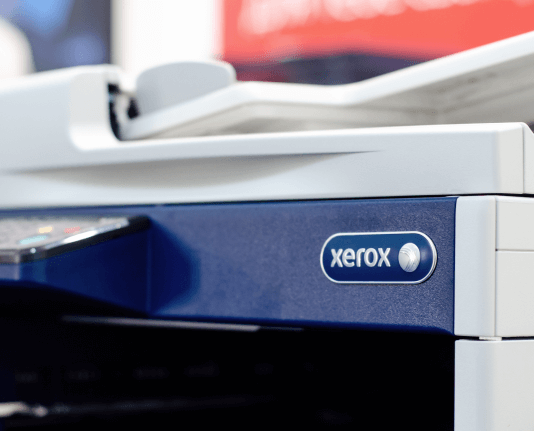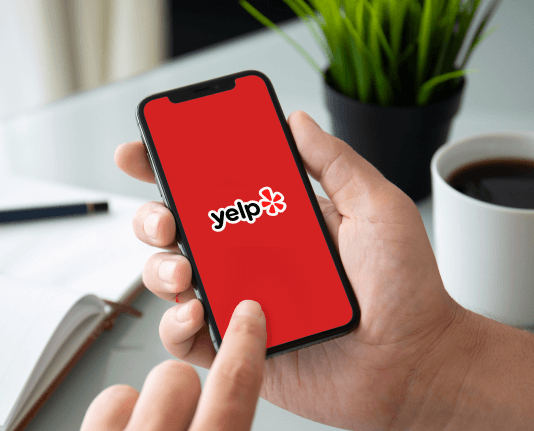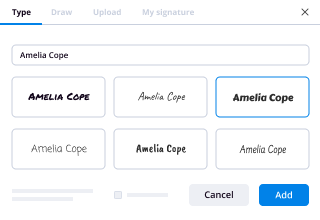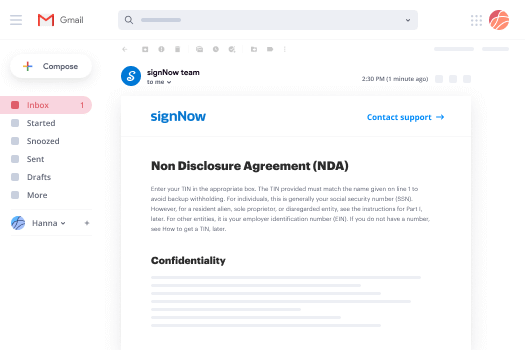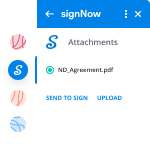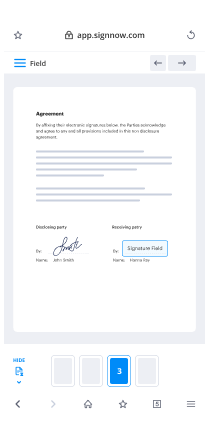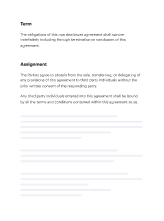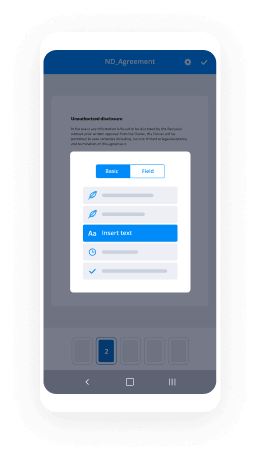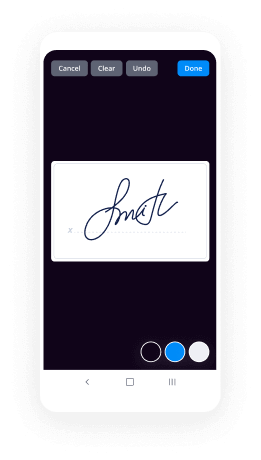How To Integrate eSign in Android
Contact Sales
Make the most out of your eSignature workflows with airSlate SignNow
Extensive suite of eSignature tools
Robust integration and API capabilities
Advanced security and compliance
Various collaboration tools
Enjoyable and stress-free signing experience
Extensive support
Keep your eSignature workflows on track
Our user reviews speak for themselves






How to incorporate e-signatures with airSlate SignNow
If you're searching for a smooth method to handle your documents via e-signatures, discover how to incorporate e-signatures with airSlate SignNow. This platform enables organizations to send and sign documents effortlessly, providing an economical solution designed for small to medium-sized businesses. With its intuitive interface and comprehensive feature set, airSlate SignNow is built to improve your document management experience.
How to incorporate e-signatures with airSlate SignNow
- Launch your web browser and go to the airSlate SignNow homepage.
- Create a complimentary trial account or log in if you already possess an account.
- Choose the document you want to sign or send for signing by uploading it to the platform.
- If you foresee using this document again, convert it into a template for future reference.
- Access your uploaded document to make necessary modifications: insert fillable fields or required data.
- Sign the document yourself and designate signature fields for the recipients.
- Click 'Continue' to set up and send the eSignature invitation.
By following these instructions, you can effectively incorporate e-signatures into your business process using airSlate SignNow. This platform not only streamlines the signing procedure but also increases productivity and collaboration.
Ready to revolutionize your document management? Sign up for airSlate SignNow today and enjoy exceptional support, clear pricing, and a powerful feature set that provides excellent ROI!
How it works
Rate your experience
-
Best ROI. Our customers achieve an average 7x ROI within the first six months.
-
Scales with your use cases. From SMBs to mid-market, airSlate SignNow delivers results for businesses of all sizes.
-
Intuitive UI and API. Sign and send documents from your apps in minutes.
A smarter way to work: —how to industry sign banking integrate
FAQs
-
How to integrate e-signatures into my existing workflow?
To integrate e-signatures into your existing workflow, airSlate SignNow provides seamless API integration options. You can easily connect your current software with SignNow to streamline document signing processes. For detailed guidance on how to integrate e, refer to our integration documentation.
-
What are the pricing options for airSlate SignNow?
airSlate SignNow offers flexible pricing plans to suit various business needs. Whether you are a small business or a large enterprise, you can find a plan that fits your budget. Visit our pricing page to learn how to integrate e-signatures at a cost-effective rate.
-
Can I customize the e-signature process?
Yes, airSlate SignNow allows you to customize the e-signature process to align with your business requirements. You can add your branding, choose signing workflows, and tailor notifications. This level of customization shows you how to integrate e-signatures effectively into your operations.
-
What features does airSlate SignNow offer for document management?
airSlate SignNow offers robust features for document management, including templates, document sharing, and real-time tracking. These tools enhance your ability to manage documents efficiently. Discover how to integrate e-signatures and document management in one cohesive platform.
-
How to integrate e-signatures with third-party applications?
Integrating e-signatures with third-party applications is straightforward with airSlate SignNow's extensive integration capabilities. You can connect with popular tools like Salesforce or Google Drive easily. Check our integration guide to learn how to integrate e-signatures with your favorite apps.
-
Is airSlate SignNow compliant with legal standards?
Absolutely! airSlate SignNow complies with all legal standards for electronic signatures, ensuring that your signed documents are legally binding. This compliance is crucial for businesses looking to understand how to integrate e-signatures responsibly.
-
What are the benefits of using airSlate SignNow for e-signatures?
Using airSlate SignNow for e-signatures offers numerous benefits, including increased efficiency, reduced turnaround times, and enhanced security. These advantages help businesses save time and resources. Learning how to integrate e-signatures into your processes can signNowly improve your overall productivity.
-
Is there a way to integrate a WooCommerce site into a mobile app that has the functionality of Uber?
Yes, there is a plugin which can integrate your WooCommerce site into a mobile app that has the functionality of Uber and that plugin is MageNative.MageNative WooCommerce App Builder is the best plugin to convert your store into a native Mobile App. It is the most exclusive and unique platform in the mCommerce industry which build Native Android and IOS mobile App for various eCommerce platforms like Magento 1, Magento 2, Shopify and WooCommerce.Magenative supports some of the payment gateways. I would like to name few:ChequeBank TransferAuthorizeNetCash On DeliveryStripePesapalPayUPaypal AdaptivePaypal StandardFeatures of WooCommerce AppMulti - Lingual and RTL Support: It supports multiple languages and the right to left theme. In the right to the left theme, writing starts from the right of the page and continues to the left.Supports all product type: It supports all type of the products available in a WooCommerce Store.Search: Enhanced search feature available to search the required product in the app based Name, description, Category of the product.Attractive and User-Friendly Layout: Provides an attractive and user-friendly layout that makes the users instinctively experience, how to use the interface.Push Notification: Using Push Notification the MageNative App sends the user a notification message regarding any new offer or any other app related messages without the user being actually required to open the app.Social Login: A single sign-in technology is used that allows users to authenticate themselves on MageNative App by connecting through a social media such as Facebook and Google.Real-Time Synchronization: Changes made onto the e-commerce platform are reflected in the m-commerce platform in near-real time and vice versa.Some Exciting FeaturesBarcode Scanner - Your customer can scan the barcode of any product and search it at your mcommerce store.2. RTL - Supports Arabic, Hebrew and other right-to-left compatible languages.3. OTP and Phone No. Login - Hassle Free sign up and Login.You can go through our Demo for Google Play and App Store so that your query can be resolved easily.MageNative provides 30 days free trial also so that you need not worry about the Apps, you can try it first for 30 days free of cost and then make your decision.MageNative deals with the various eCommerce platform like-Magento1 Mobile AppMagento 2 Mobile AppShopify Mobile AppWooCommerce Mobile App
-
How do I get started with Android application development with only a very basic knowledge about programming?
Thanks for the A2A Rahul , It’s very easy to get start with Android Application Development. Few months back I read an Awesome article about Android Apps Development ,I thought it would be very helpful for a Beginner in Android App development. So , I have shared the article here. I hope so , sure It will be a very helpful Guide For Apps developing beginners. So you have a killer app idea and you’re ready to turn it into a reality and take it to market. No doubt you’re itching to start getting your first downloads, reviews and profits… But there’s just one problem: you don’t have a clue where to start! Learning to code is difficult enough on its own but with Android development it can be more complicated. Not only do you need to understand Java, you also need to install all the Android-specific software and learn all of the unique quirks of Android app development. In general, creating an Android app requires the SDK (Software Development Kit), an IDE (Integrated Development Environment) like Android Studio or Eclipse, the Java Software Development Kit (JDK) and a virtual device to test on. All this takes work to set up, and that’s before you’ve even started looking into things like Google Play Services, screen sizes, API levels… It’s just such a dense amount of information and it’s enough to put an awful lot of people off before they even begin. My aim with this article then, is to provide an approachable guide to try and make the whole prospect of creating an app a little less daunting… I’ll explain the bits you need to know and gloss over the rest and by the end you should have a basic app that you can start iterating on and experimenting with. Go and make yourself a cup of tea first though, this may take a while… Step 1: Download Android Studio To program in most languages, you need a piece of software called an IDE or ‘Integrated Development Environment’. The most common IDE for Android development is Android Studio, which comes direct from Google itself. You can get it here [ http://developer.android.com/sdk/index.html?gclid=Cj0KEQiAm-CyBRDx65nBhcmVtbIBEiQA7zm8lWCaBd9n9KYYunFXxXsQCPojBVHk5eIH4p9CWM1eLfUaAmd28P8HAQ ]. An IDE is what gives you the main UI where you’ll enter your code (you can’t just start typing into notepad). It also highlights things you get wrong, offers suggestions and lets you run and test your creations conveniently. It creates the files you need, it provides basic layouts and generally it saves you a lot of time and effort. What’s great about Android Studio is that it is designed specifically for Android development (unlike the second most popular option, Eclipse). This means that when you download the software, you’ll also get a lot of the other bits you need including the Android SDK (a selection of tools including the Android platform itself) and the Android Virtual Device, which is an emulator you can test your apps on. When you go through the installation, make sure you leave the boxes ticked to confirm that you want these additional components. You could manually add them later, but this will just complicate matters. As mentioned, there are some alternatives to Android Studio. Eclipse [ https://eclipse.org/downloads/ ] is an older IDE that can be used for developing other things too (such as iOS apps) and that is a bit more flexible overall. It’s also a much more fiddly to get started with though and not nearly as beginner-friendly. Another personal favorite of mine is Basic4Android [ http://www.b4x.com/ ]. Basic4Android is an IDE that lets you code Android apps with the BASIC programming language. It makes things easier in a number of other ways too and is focused on ‘rapid development’. There are other options too, such as Unity3D and numerous app builders, each of which has specific strengths and weaknesses depending on what you’re planning on building. For the sake of simplicity though, we’re focusing on Android Studio because it has become the ‘main’ way to build basic apps and pretty much the industry standard. If you think you might ever sell your business, if you want to give yourself the most flexibility and control possible, or if you’d like to become a professional app developer, you’ll need this tool. That said, if you read through all this and you find it too much still, you might want to consider Basic4Android as a simpler approach and I’ll be covering that in a future post. Okay, just to recap: we now have Android Studio downloaded and installed. But, don’t run it until you read step two! So far so good… What could possibly go wrong? Step 2: Setting Up Android Studio Now you have Android Studio installed you’ve taken your first, bold step toward becoming a developer! A lot of people only manage it this far and then leave the software installed on their computer for months on end, feeling guilty every time they see it in the Start Menu. Eventually they end deleting it to make space for the next AAA title on Steam and so ends the whole sorry affair… Don’t end up like them – it’s time for some more affirmative action! Before you can get started, you also need to install Java on your machine to use Android Studio. Specifically, you’re going to need install the Java Development Kit (JDK). Java is the programming language you’re going to be using to build your apps in this instance and you need to install the JDK in order for Android Studio to be able to interpret and compile your code (compiling means turning the source into something that is understood by the CPU – machine code). You’ll find the Java Development Kit here [ http://www.oracle.com/technetwork/java/javase/downloads/jdk8-downloads-2133151.html ]. Just download and follow the instructions to install. Now you can click on Android Studio to launch it. Once it opens up, you’ll be presented with a menu where you’ll be able to get started or configure some options. The great thing is that everything is handled for you at this point, though you may want to familiarize yourself with the SDK Manager(Configure %3E SDK Manager) which is where you’ll update your Android SDK to support newer versions, as well as download things like code samples or support for Google Glass. But don’t worry about that now but if Android Studio says you’re missing something, this is where you’ll probably need to go to find it. So really there are three main things interacting when you use Android Studio to create your apps. * Android Studio itself, which is an IDE that provides you with a nice interface for coding. * The code you write in Java, which you installed a moment ago… * And the Android SDK which you’ll access through your Java code in order to do Android-type things If you find this all a bit complicated and daunting then… well, you don’t know you’re born. This used to be way worse. Maybe that offers some consolation… Step 3: Starting a New Project Once you’ve installed your samples, you can go back to the first page you saw when you loaded up Android Studio. Now you want to choose Start a new Android Studio Project – it’s finally happening! Enter the name you want for your application and your ‘company domain’. Together these elements will be used to create your package name with the following format: com.companyname.appname The package will be the compiled file or APK (‘Android Package File’) that you’ll eventually upload to the Google Play Store. There are ways that people can see this, so if you’re planning on making something you’ll eventually release, try to stay away from using ‘funny words’. The last field to enter is the directory where you want to save all the files pertaining to your app. I like to save in DropBox to make sure I always have a backup of my code. Click Next again and guess what… More options! Huzzah! Don’t worry, we’re nearly there… Next you need to decide what type of device you’re going to be developing for and in this case we’ll start with the Phone and Tablet option. Other options are TV, Wear and Glass. It’s fine if you want to develop for a myriad of platforms in the future – that’s one of the wonders of Android – but let’s start with something a bit more straightforward to begin with, okay? The other choice you have to make at this stage is the ‘Minimum SDK’. This is the lowest version of Android you want to support. Why not just enter the latest version of Android in here? Well, because relatively few people actually have the latest version of Android installed on their device at any given time. You want to support phones that are still running older versions in order to signNow the largest possible audience – especially overseas. Why not just go with Android 1.1? Well, apart from this not being an option (Froyo is as low as you can go), that would also prevent you from using any of the fancy new features from the latest updates. The best bet at this stage is to go with the default option, so just leave this field as it is. On the next page, you’ll be given the option to pick the way you want your app to look at the start. This will be the look of your main ‘Activity Module’ which is basically the main page of your app. Think of these like templates; do you want to have the title of your app along the top of the screen, or do you want your UI to fill the whole display? Do you want to start off with some elements ready-designed for you? Is your app primarily going to use Google Maps (don’t go here for a bit, things get more complicated with Google Play Services). Bear in mind that an app can have multiple activities that act like separate pages on a website. You might have a ‘settings’ activity for instance and a ‘main’ activity. So the activity isn’t the app per say but rather one stand-alone page of your app. For your first creation though, you’ll probably do best to make something really simple that just displays a single, basic activity. Select ‘Basic Activity’ to keep things as simple as possible and for all intents and purposes, this will now be your app. Click Next again you get the last few options. Now you get to pick the name for your activity and the layout name (if you chose ‘Basic Activity’ you’ll also have the title option and the ‘menu_resource’ name). The activity name is how you’ll refer to your activities in your code, so call it something logical (good advice for coding generally) like ‘MainActivity’. Creative, I know. The layout name meanwhile describes a file that determines the layout of an activity. This is a separate piece of code that runs in concert with the main activity code to define where elements like images and menus go and what fonts you’ll use. This is actually not Java but XML – or Extensible Markup Language if you want to impress your friends. For anyone with a background in web development, your XML is going to work a little like HTML or a CSS style sheet. The Java code for the activity meanwhile says what the elements on the screen do when pressed etc. It’s fine to leave the default name here as ‘activity_main’. Lastly, choose a name for the menu and for the title. Pick something nice for the title, as your users will be able to see this at some points. Click next… and now you get to see your app! Your blank, useless app… All that just to get started! You see why people give up? But really we can break it down into the following very basic steps: * Download and install Android Studio, making sure to include the Android SDK * Install Java SDK * Start a new project and select the basic details So it’s really not that bad… And remember: once you’ve done all this once, you can forget about it forever and focus on the fun stuff: creating apps! Your tea is probably cold at this point, so the next very important step, is to get more. Step 4: Making an Actual Thing Once your app opens, you should see a directory tree on the left with all the different files and folders that make up your app and a picture of a phone displaying ‘Hello World!’ in the center. Well, hello to you as well! (A basic app that displays ‘Hello World’ is what most new developers make first when they learn to program in a new language. Android Studio cheats though, because it does it for you!) You might notice that the open tab (along the top) is ‘activity_main.xml’, which is what the big phone is showing on its display. You may recall that activity_main.xml is the XML code that defines the layout instructions for your main activity. If you selected ‘Basic Activity’ when you started your project, then you’ll see a second XML file too called ‘content_main.xml’. For the most part, these two do the same thing but the ‘acitvity_main.xml’ contains the basic layout that Android Studio created for you when you selected ‘Basic Activity’. The stuff you want to edit is in content_main.xml, so open that up and don’t worry about it for now. (If this isn’t what is open to start, then use the directory on the left to open it by choosing: app %3E res %3E content_main.xml.) The Layout Android Studio is not showing the XML code itself here but rather a rendering of how the layout will appear on the screen. This is a visual editor a bit like Dreamweaver for web design and it makes life a little easier for us developers. You also have a bunch of options called ‘widgets’ down the left that you can add to your app. This is your basic app stuff; so for instance, if you want to add a button saying ‘OK’ to your activity, you can simply drag it over to the screen and drop it anywhere you like. Go ahead and dump an ‘OK’ button right underneath the ‘Hello World’. Something else you’ll find is that you can click on either of these elements in order to change the text and the ‘ID’. The ID is how you’re refer to each element (called a ‘view’) in your Java code, while the text is of course what you display to the user. Delete the ‘Hello World’ widget (or view) and change the text on the button to ‘Hello?’. Likewise, change the ‘id’ on the button to ‘button1’. I am now stealthily getting you to write a little program… Notice as well that when you select a view, you get options in the bottom right to change the text color and size etc. You can play around with these variables if you like to change the look of your button. We’re coming back here in a minute though so make a mental note! Now open up your MainActivity.java. The tab will be along the top but in case it isn’t, find it under:App %3E Java. This is the code that defines the behavior of your app. At this stage, you’re going to add in a little passage of code: [code]public void buttonOnClick(View v) { Button button1 = (Button) v; ((Button) v).setText("Hello!"); } [/code]This is going to go right underneath the first lone closed bracket ‘}’, just before the “@Override, Public Boolean”. It should look like this: What does it all mean? Well basically, anything following “void buttonOnClick” will be carried out when someone clicks on the button. We’re then finding the button with the “Button button1 = (Button) v;” code and then changing the text. Yes, there are other ways you could achieve the same thing but I feel like this keeps it nice and simple and thus easy to understand. Spend some time reading it and try to get your head around what is doing what… At the top of the page is the word ‘import…’. Click on that to expand it and make sure that somewhere there is the line: “import android.widget.Button;”. It should have appeared on its own when you typed out the last bit (Android Studio is smart like that) but you can add it yourself if it didn’t. (Notice as we type that lines end in “;”. This is basic Java formatting and if you forget one, it will throw up an error. Get used to searching around for them!) Now go back to your content_main.xml and click on the button. In the right corner, where you have your parameters for the button, you should be able to find an option called ‘onClick’. Click on this and then select the ‘onClick’ line of code you just wrote from the drop down menu. What you’ve just done, is told Android Studio that you want to associate the section of code with the button you created (because you’ll have lots of buttons in future). Now all that’s left to do is run the app you just made. Simple go to ‘run’ along the top and then select ‘run app’ from the drop down menu. You should already have your AVD (Android Virtual Device) installed but if not, you can go to: tools %3E Android %3E AVD Manager %3E + Create Virtual Device. Don’t forget you also need to install an Android version onto the device. Follow the steps to launch the emulator running your app. Be patient, it can sometimes take an age to load up… If it neverloads up, you can consider ‘packaging’ the app in order to create an APK. Drag this onto your Android device and double click on it to install and run it. Once it’s finally up and running you can have a go with this fun, fun app. What you should find is that when you click the button, the text from ‘Hello?’ to ‘Hello!’. We’re going to be rich… (If it doesn’t work… something has gone wrong. It wasn’t me, my one works! Look for red text in your code and hover your mouse over it to get suggestions from Android Studio.) Step 5: How to Get Better At App Development Okay, so that was a lie. We’re probably not going to be rich. At the moment the app we’ve made is pretty lame. You can try and sell it sure but you probably won’t get that many good reviews. The reason I talked you through this basic app creation though is because it teaches you the very fundamentals of programming. You have an action and a reaction – pressing on a button doessomething. Throw in some variables and some math, add some pretty images and a useful function and that’s genuinely enough to make a very basic app. So where do we go from here? There’s so much more to learn: we haven’t looked at the Android Manifest yet, we haven’t talked about your private keysign (or how fun it is when you lose that) and we haven’t even studied the Android app ‘lifecycle’ (nothing to do with The Lion King). There’s issues with supporting different screen sizes and there’s just so much more to learn. Unfortunately, it would take an entire book to teach you the entirety of Android app development. So that’s a good place to start: buy a book! But more important is just to play around and try things. Don’t set out to make your world-changing app on day one. Instead, focus on making something simple and straightforward and then build on that. Try changing the layout of the text and try adding in more buttons and more rules to make your app actually useful. Eventually, you’ll find there’s something you want to do that you can’t figure out on your own. Maybe you want a sound to play when someone clicks on your button, for example. This is where the real learning starts. Now all you need to do is search in Google: “How to play sound onClick Android” You’ll find a bunch of complicated answers but eventually someone, probably on Stack Overflow [ http://stackoverflow.com/ ], will break down the answer simply for you. Then what you do is you copy that code and you paste it into your app, making a few changes as you go. Likewise, try out some of the code samples available through Android studio. See how they work, try changing things and just experiment. Things will go wrong and error messages will come up but for the most part, if you just follow the instructions, it’s easy enough to handle. Don’t panic! And that’s pretty much how you learn to make apps. A lot of it boils down to reverse engineering and copying and pasting. Once you have the main program in place, the rest you pick up as you go. If you want the absolute easiest way to start, then just find some sample code that’s close to what you make and change it. No one is going to be able to explain all this to you in a way that makes any sense and if you worry about not grasping everything to begin with, you’ll never get anywhere. So instead, dive in, get your hands dirty and learn on the job. It’s complicated and it’s frustrating but ultimately it’s highly rewarding and more than worth the initial effort. EDIT: Added Source : http://www.androidauthority.com/android-app-development-complete-beginners-658469/
-
How can I add Firebase to Android?
Add Firebase to Your Android projectPrior RequirementsA device that runs on Android 2.3 (GingerBread) or higher version and Google Play services 9.2.1 or higher.Google Play services SDK from the Android SDK ManagerAndroid Studio 1.5 or higherAn Android Studio project and its package nameIt has to be noted that the feature Instant Run in Android Studio prior to the version 2.2 is incompatible with Firebase Analytics and may be preventing certain events from collection. Hence, it is recommended that you either disable instant run or upgrade to Android Studio 2.2. Incase you are using a quick start remember of getting the package name from the ApplicationManifest.xml.Adding Firebase to your applicationYou will be needing a Firebase project and a Firebase configuration file for your app.Create a Firebase project in the Firebase console, if you don’t already have one. On the other hand if you are having an existing Google project in association with your mobile app, click import Google Project. Otherwise, click Create New Project.Click Add Firebase to your Android app and keep following the setup steps. If you are importing an existing Google project this may be happening automatically and you can download the config file. For more details on downloading the config file visit Download a configuration fileWhen prompted you must enter the app’s package name. It is important for entering the package name your app is using which can only be set when you add an application to your Firebase project.Next you need to download the google-services.json file You can download this file again at any time. For more information please visit Download a configuration fileCopy this file into your project’s module folder typically app/If you are having multiple build variables with different package names defined each application must be added to your project in Firebase console.Adding the SDKIf you feel that there is a necessity of integrating Firebase Libraries into one of your own projects you must be performing a few fundamental tasks of preparing your Studio project. You may have already done this as part of adding Firebase to your app.First you are required to add rules in your root level build.gradle file for including google service pluginbuildscript {// ...dependencies {// ...classpath 'com.google.gms:google-services:3.0.0'}}Next in your module Gradle file (usually the app/build.gradle), add the apply plugin line at the bottom of the file for enabling Gradle plugin:apply plugin: 'com.android.application'android {// ...}dependencies {// ...compile 'com.google.firebase:firebase-core:9.2.1'}// ADD THIS AT THE BOTTOMapply plugin: 'com.google.gms.google-services'You should also be adding the dependencies of the Firebase SDKs you are willing to use we are recommending starting with the firebase-core, which include Firebase Analytics.Available Libraries
-
How to display ads in an android app?
The new AdMob is a streamlined user interface, to make it even easier for you to monetise and promote your apps in minutes. Maximize your earnings with the new AdMob improved tools to help app developers build thier business. We will create a simple view that launches an Interstitial on start and show a single banner advertisement.Here you need to Sign up from an Admob Publisher here. Log in to your dashboard once you have your account approved.Identify your publisher ID .......you can start further process from below link:Integrating New Google Admob with Banner and Interstitial ads - AndroidBegin if you work with Configure.IT then then select AdView from control list go to properties from and select AdMobnow configure your select AdMob and set API key from right side third party optionit's a too easy process to integrate AdMob in Configure.IT
-
How do you use LaTeX mathematical notation for formulae on Quora?
From our Help Center article, How do you use LaTeX mathematical notation for formulae on Quora?:You can write LaTeX and have it styled correctly by using the Math formatting option in the Quora editor (see screenshot) or by using the keyboard shortcut.For more information about Quora’s features and frequently asked questions, check out our Help Center.
-
How can I integrate MATLAB code to Android?
If you have an additional product, MATLAB Builder JA for Java, you can produce a .jar file from your MATLAB code.However, the .jar file requires the MATLAB Compiler Runtime (a freely redistributable component that you get with MATLAB Compiler and MATLAB Builder products) to be present. The MCR has a much larger footprint than is suitable for the typical Android device (it's like a copy of MATLAB itself, without the user interface).You could think about eitherRunning your MATLAB .jar file remotely on a server, and having your Android application connect to it, orInstead of using MATLAB Compiler and Builder products, use MATLAB Coder, which will convert a subset of the MATLAB language directly into C code. This C code doesn't require the MCR, and could be compiled to run directly on Android. Make sure your MATLAB algorithm falls within, or can be expressed in, the appropriate subset of the MATLAB language.
Trusted esignature solution— what our customers are saying
Get legally-binding signatures now!
Related searches to How To Integrate eSign in Android
Frequently asked questions
How do i add an electronic signature to a word document?
How do you know an electronic signature is real?
How to e sign to a uscis e-filing status?
Get more for How To Integrate eSign in Android
Find out other How To Integrate eSign in Android
- The concession stand order form questions contact
- Document templates for intranet scenario microsoft qampampa form
- Landlord liability 495559544 form
- Purchase money mortgage form 495566562
- Token transit agreement form
- Power of attorney for import nippon express usa form
- This acx audiobook license and distribution agreement form
- Finderexecutive producer agreement form
- Dental invoice pdf form
- Travel player ampamp parent agreementweston basketball form
- Dynasty trust template form
- Please send this form along with all applicable receipts to
- 15girls night out at the flower show thurs markzwick com form
- Termination form 495567782
- Memorandum of agreement form
- Carrot 3 booster seat child restraint system convaid form
- Park permit request condominium form pdf
- Code of conduct template form
- Ahs contractor portal form
- Business purchase letter of intent template pdf form

